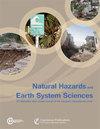采用水动力-统计模型相结合的方法确定河口复合洪水的阈值
IF 4.2
2区 地球科学
Q1 GEOSCIENCES, MULTIDISCIPLINARY
引用次数: 0
摘要
摘要当极端海平面和河流排水量同时或相继出现,淹没低洼沿海地区时,就会发生河口复合洪水。此类事件难以预测,并会扩大危害。英国最近发生的风暴,包括德斯蒙德风暴(2015 年)和希拉拉风暴(2020 年),突出表明了面向大西洋的山区集水区易受复合洪水的影响,包括生命危险和短期及长期的社会经济损失。为了改善复合洪水的预测和预警,需要建立海河综合阈值。在这项研究中,我们利用观测数据和数字模型重建了一个特别易受复合洪水影响的河口(北威尔士康威)的历史洪水记录。该记录被用于开发一种方法,利用理想化模拟和联合概率分析来确定洪水的海平面和河流排水量组合阈值。结果显示了洪水泛滥范围如何对总水位和河流排水量的增加做出反应,在某些情况下,洪水泛滥范围会因复合驱动因素而显著扩大,并且由于驱动因素之间存在 3 小时的时间差,洪水泛滥的敏感性(∼ 7%)也会增加。风暴潮大小(作为总水位的一个组成部分)对洪水范围的影响仅在发生轻微洪水的情况下才重要。复合洪水发生的时间和地点存在差异;最有可能发生在中等海河条件下(如第 60-70 百分位数和第 30-50 百分位数),且仅发生在中河口区。在这种情况下,联合概率分析对于确定复合洪水风险行为非常重要。在河口的其他地方,海况(河口下游)或河水流量(河口上游)主导着洪水风险,单值概率分析就足够了。这些方法可应用于世界各地的河口,以确定特定地点的洪水阈值,为应急响应和长期沿岸管理计划提供支持。本文章由计算机程序翻译,如有差异,请以英文原文为准。
Thresholds for estuarine compound flooding using a combined hydrodynamic–statistical modelling approach
Abstract. Estuarine compound flooding can happen when extreme sea level and river discharges occur concurrently, or in close succession, inundating low-lying coastal regions. Such events are hard to predict and amplify the hazard. Recent UK storms, including Storm Desmond (2015) and Ciara (2020), have highlighted the vulnerability of mountainous Atlantic-facing catchments to the impacts of compound flooding including risk to life and short- and long-term socio-economic damages. To improve prediction and early warning of compound flooding, combined sea and river thresholds need to be established. In this study, observational data and numerical modelling were used to reconstruct the historic flood record of an estuary particularly vulnerable to compound flooding (Conwy, North Wales). The record was used to develop a method for identifying combined sea level and river discharge thresholds for flooding using idealised simulations and joint-probability analyses. The results show how flooding extent responds to increasing total water level and river discharge, with notable amplification in flood extent due to the compounding drivers in some circumstances, and sensitivity (∼ 7 %) due to a 3 h time lag between the drivers. The influence of storm surge magnitude (as a component of total water level) on the flooding extent was only important for scenarios with minor flooding. There was variability as to when and where compound flooding occurred; it was most likely under moderate sea and river conditions (e.g. 60th–70th and 30th–50th percentiles) and only in the middle-estuary zone. For such cases, joint-probability analysis is important for establishing compound flood risk behaviour. Elsewhere in the estuary, either the sea state (lower estuary) or river flow (upper estuary) dominated the hazard, and single-value probability analysis is sufficient. These methods can be applied to estuaries worldwide to identify site-specific thresholds for flooding to support emergency response and long-term coastal management plans.
求助全文
通过发布文献求助,成功后即可免费获取论文全文。
去求助
来源期刊
CiteScore
7.60
自引率
6.50%
发文量
192
审稿时长
3.8 months
期刊介绍:
Natural Hazards and Earth System Sciences (NHESS) is an interdisciplinary and international journal dedicated to the public discussion and open-access publication of high-quality studies and original research on natural hazards and their consequences. Embracing a holistic Earth system science approach, NHESS serves a wide and diverse community of research scientists, practitioners, and decision makers concerned with detection of natural hazards, monitoring and modelling, vulnerability and risk assessment, and the design and implementation of mitigation and adaptation strategies, including economical, societal, and educational aspects.

 求助内容:
求助内容: 应助结果提醒方式:
应助结果提醒方式:


